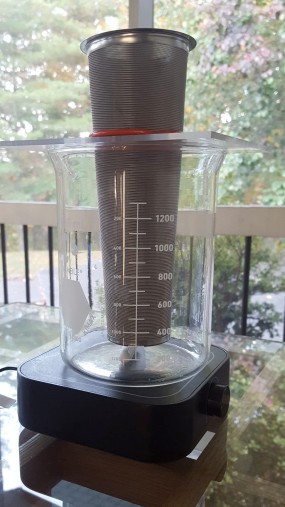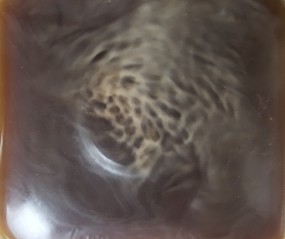
Iced coffee maker used in the experiment. The black box under the beaker is a magnetic stirrer. Whether you get filtered or unfiltered coffee depends on whether you put the coffee through the metal strainer before or after stirring overnight in the refrigerator. Note that unlike hot brewed coffee, coffee made this way isn't sterile, so it should be made and stored in the refrigerator.
 nfiltered iced coffee is easy to make: mix coffee with water in the fridge,
stir overnight, then remove the grounds using a strainer. Upon storage, a
beige-colored lipid supernatant forms on the top. This is coffee oils,
including the diterpenes cafestol and kahweol [1]. It's been
claimed that unfiltered coffee has 30 times more diterpenes than filtered coffee
(but see below).
nfiltered iced coffee is easy to make: mix coffee with water in the fridge,
stir overnight, then remove the grounds using a strainer. Upon storage, a
beige-colored lipid supernatant forms on the top. This is coffee oils,
including the diterpenes cafestol and kahweol [1]. It's been
claimed that unfiltered coffee has 30 times more diterpenes than filtered coffee
(but see below).
The top layer should be mixed with the rest of the coffee before drinking it unless you like expresso, as it's also rich in caffeine. Or you could pour the coffee through a paper filter, which will absorb some of the oils. Some Internet sites recommend using a charcoal filter, but this is overkill as it would absorb the caffeine, tannins, and pretty much everything else, giving you not much more than a cup of cold water.
Iced coffee made using the manufacturer's instructions was indeed sweeter than regular coffee as everyone claims, mainly because it was much more dilute. Clearly some engineering was needed. The solution (shown at right) was to add a 9 mm diameter × 2 inch long Teflon-coated stirring bar and a small magnetic stirrer. By stirring it instead of waiting for diffusion, you get normal-tasting iced coffee that can be stored for a week in the fridge and needs no ice cubes.
The table below shows that filtered iced coffee and coffee made by a standard drip-style coffee maker were equally good at extracting the caffeine and oils from coffee grounds. Unfiltered iced coffee was 1.54 times more efficient, meaning it was 54% stronger than regular hot coffee from a GE Coffeematic II drip coffeemaker, which uses a paper coffee filter.
| Sample | Net weight (g) | Pct. recovery |
|---|---|---|
| Water | 0.000 | 0.0 |
| Coffee grounds | 0.154 | 100.0 |
| Filtered iced coffee | 0.038 | 24.7 |
| Unfiltered iced coffee | 0.053 | 34.4 |
| Drip coffee maker | 0.031 | 20.1 |
Caffeine and terpenes from 25 ml coffee or an equivalent weight of coffee grounds (1.9 g) brought to 25 ml with water were extracted with 25 ml of ethyl acetate at room temperature. The solvent was dried and the solid residue, which contained the caffeine and coffee oils, was weighed.
Get at least two stirring bars. They're slippery little devils. If they don't go down the drain, they get lost in the trash.
The challenge is how to fit all that stuff in the fridge. I first tested a Scilogex stirrer, which was only 5/16 inch thick. It's great for small things but it was too weak to stir the coffee, barely rotating the stirring bar even in a beaker with a flat bottom. It was nicely manufactured, had no moving parts, but the DTS100 mainboard inside would have been tough to re-engineer. A cheaper one from a Chinese company named West Tune (part no. MS3000) was 1¾ inches thick and was strong enough to produce a vigorous vortex in the fridge. Both ran on a 12 volt wall wart and used five watts. This is important—the thin cable doesn't interfere with the door, and you wouldn't want 120 volt equipment in your fridge even if it was on a GFCI.

Caffeine coffee mugs given out as a sales prop by Fisher Scientific, a company that sells lab chemicals and supplies
Cafestol, bad foe or really bad foe?
Unfiltered coffee contains more cafestol than filtered coffee. Every source I checked repeated the same claim, which they seem to have gotten from a common source: cafestol raises your LDL, which causes cardiovascular disease, giving the impression that it is highly dangerous. But is any of this really true?
The fact is that it's not such a simple matter of HDL = good and LDL = bad. Even clinical labs distinguish between VLDL-C (very low density lipoprotein bound to cholesterol), HDL-C (high density lipoprotein bound to cholesterol), TC (total cholesterol), sd-LDL (small dense LDL), and TG (triglycerides). Some researchers now say that because HDL-C is such an important component of cholesterol efflux, high HDL-C may be far more relevant to cardiovascular health than low LDL-C.[2]
In fact, many if not most scientists now think the risk for the average person of dietary cholesterol has been overstated. Dr Kenneth R Feingold writes: [3]
Dietary cholesterol is found in egg yolks, shrimp, beef, pork, poultry, cheese, and butter and increase LDL-C but the effect is modest and varies with approximately 15–25% of individuals being hyper-responders with more robust increases.

Coffee oils floating as a lipid layer on the surface of a jar of unfiltered coffee. Sometimes mistaken for bacteria because of the cloudiness. Coffee was made from 4 scoops (76 grams) per liter of water for 8h, then passed through a strainer
The challenge, of course, is determining whether you're an average person or a ‘robust hyper-responder.’
The effect on most people of cafestol and kahweol, which is identical to cafestol except for an extra double bond, is modest. The original Thelle paper [4] said that drinking 6–7 cups unfiltered coffee per day raised LDL-C from around 3 to 3.85 mmol/l (0.13 mmol/l increase per cup). However, an earlier study by AA Bak [5] found about half that: 0.078 mmol/l increase per cup, or about a 10% increase for 4–6 cups a day for nine weeks.
More recent reports [6][7] suggest that the increase is due to suppression of LDL receptor activity. Cafestol was also said to work by “affecting” cholesterol ester transfer protein (CETP), an enzyme that catalyzes cholesterol binding to its lipoprotein carrier.[3] By this the author meant that it raises CETP by up to 18 ± 4.3% and raises PLTP (phospholipid transfer protein) by up to 7%.[8] B. De Roos et al. found that LDL-C increased from 3.00 ± 0.2 to 3.56 ± 0.16 mmol/liter in patients drinking 0.9 liters of French press (unfiltered) coffee a day for 12 weeks. This was barely statistically significant at p = 0.034.[8]
Thelle showed that filtered coffee also raises serum cholesterol by 0.22–0.36 mmol/l. [9]
Despite these small but significant effects, cafestol and kahweol also show many apparent benefits. Like caffeine, cafestol induces the Nrf2 pathway, contributing to coffee's supposed neuroprotective effect.[10] Sokała et al. say:

Structure of Cafestol. Note the structural resemblance to cholesterol. The arrow points to the location of a double bond in kahweol, which is otherwise identical [13]
Although these two compounds are known mainly from their hypercholesterolemic effects, a growing body of evidence shows that kahweol and cafestol also have many beneficial effects such as anti-inflammatory, antioxidant, hepatoprotective, anti-diabetic, and anti-carcinogenic [11] activities. However, data on the neuroprotective properties of these two compounds are quite limited.[1]
It bears repeating that new studies on diet and cardiovascular disease are extremely expensive, so researchers are strongly disincentivized from studying something mundane like coffee in clinical trials; thus, the benefits and risks of drinking coffee have been debated using small trials for years. Steven E Nissen said it best: US dietary guidelines are an evidence-free zone.[12] It often seems to follow the golden rule of toxicology: if it's thought to be safe, it will turn out to be bad for you, and vice versa.
[1] Socała K, Szopa A, Serefko A, Poleszak E, Wlaź P. Neuroprotective Effects of Coffee Bioactive Compounds: A Review. Int J Mol Sci. 2020 Dec 24;22(1):107. doi: 10.3390/ijms22010107. PMID: 33374338; PMCID: PMC7795778.
[2] Kang H, Song J, Cheng Y. HDL regulates the risk of cardiometabolic and inflammatory-related diseases: Focusing on cholesterol efflux capacity. Int Immunopharmacol. 2024 Sep 10;138:112622. doi: 10.1016/j.intimp.2024.112622. Epub 2024 Jul 6. PMID: 38971111.
[3] Feingold KR, Anawalt B, Blackman MR, Boyce A, Chrousos G, Corpas E, de Herder WW, Dhatariya K, Dungan K, Hofland J, Kalra S, Kaltsas G, Kapoor N, Koch C, Kopp P, Korbonits M, Kovacs CS, Kuohung W, Laferrère B, Levy M, McGee EA, McLachlan R, New M, Purnell J, Sahay R, Shah AS, Singer F, Sperling MA, Stratakis CA, Trence DL, Wilson DP, editors. The Effect of Diet on Cardiovascular Disease and Lipid and Lipoprotein Levels. 2024 Mar 31. Endotext [Internet]. South Dartmouth (MA): MDText.com, Inc. PMID: 33945244. Open source book
[4] Thelle DS. Coffee, cholesterol, and coronary heart disease. BMJ. 1991 Apr 6;302(6780):804. doi: 10.1136/bmj.302.6780.804. PMID: 2025702; PMCID: PMC1669189.
[5] Bak AA, Grobbee DE. The effect on serum cholesterol levels of coffee brewed by filtering or boiling. N Engl J Med. 1989 Nov 23;321(21):1432–1437. doi: 10.1056/NEJM198911233212103. PMID: 2811958.
[6] De Roos B, Van Tol A, Urgert R, Scheek LM, Van Gent T, Buytenhek R, Princen HM, Katan MB (2000). Consumption of French-press coffee raises cholesteryl ester transfer protein activity levels before LDL cholesterol in normolipidaemic subjects. J. Intern. Med. 2000, 248, 211–216
[7] Thelle, D.S. Coffee, tea and coronary heart disease. Curr. Opin. Lipidol. 1995, 6, 25–27 (paywalled)
[8] De Roos B, Van Tol A, Urgert R, Scheek LM, Van Gent T, Buytenhek R, Princen HM, Katan MB. Consumption of French-press coffee raises cholesteryl ester transfer protein activity levels before LDL cholesterol in normolipidaemic subjects. J Intern Med. 2000 Sep;248(3):211–216. doi: 10.1046/j.1365-2796.2000.00728.x. PMID: 10971787.
[9] Strandhagen E, Thelle DS. Filtered coffee raises serum cholesterol: results from a controlled study. Eur J Clin Nutr. 2003 Sep;57(9):1164-8. doi: 10.1038/sj.ejcn.1601668. PMID: 12947437. (paywalled)
[10] Trinh K, Andrews L, Krause J, Hanak T, Lee D, Gelb M, Pallanck L. Decaffeinated coffee and nicotine-free tobacco provide neuroprotection in Drosophila models of Parkinson's disease through an NRF2-dependent mechanism. J. Neurosci. 2010, 30, 5525–5532.
[11] Eldesouki S, Qadri R, Abu Helwa R, Barqawi H, Bustanji Y, Abu-Gharbieh E, El-Huneidi W. Recent Updates on the Functional Impact of Kahweol and Cafestol on Cancer. Molecules. 2022 Oct 28;27(21):7332. doi: 10.3390/molecules27217332. PMID: 36364160; PMCID: PMC9654648.
[12] Nissen SE. U.S. Dietary Guidelines: An Evidence-Free Zone. Ann Intern Med. 2016 Apr 19;164(8):558–559. doi: 10.7326/M16-0035. PMID: 26783992. (paywalled)
[13] Ren Y, Wang C, Xu J, Wang S (2019). Cafestol and Kahweol: A Review on Their Bioactivities and Pharmacological Properties. Int J of Molecular Sciences 20, 4238–4253
oct 26 2024, 5:30 am. table added nov 01 2024. last updated feb 15 2025
